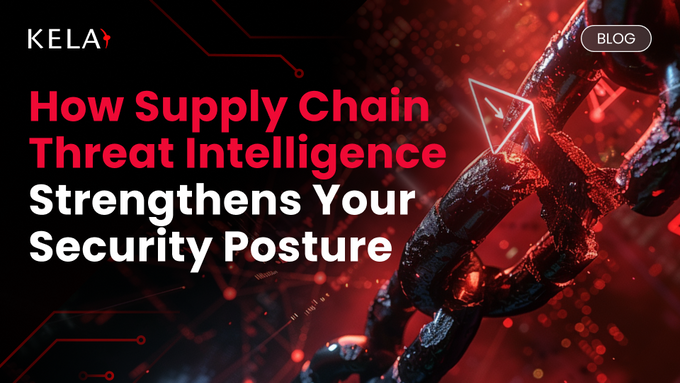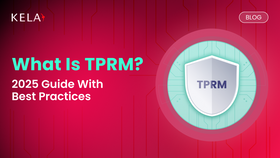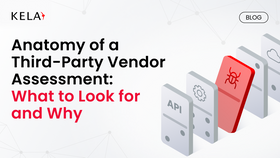How Supply Chain Threat Intelligence Strengthens Your Security Posture
This blog explores how supply chain threat intelligence improves your overall security posture by reducing third-party risks, guiding smarter vendor assessments, and helping you respond more effectively to disruptions linked to your suppliers.
Published July 5, 2025

Every business depends on a network of suppliers, vendors, and partners, but these connections can also bring security risks that affect your operations. Being aware of these risks early helps protect your organization from potential threats. Supply chain threat intelligence provides valuable insights into the tactics and motives of attackers targeting your supply chain, helping you spot vulnerabilities before they are exploited.
Using this intelligence allows you to make informed decisions that strengthen your defenses and lower the chances of disruptions caused by third-party risks. In this blog, we will discuss how supply chain threat intelligence can enhance your security posture, reduce vendor-related risks, and improve how you manage your supply chain ecosystem.
» Strengthen your cybersecurity with KELA's expertise
What Is Supply Chain Threat Intelligence?
Supply chain threat intelligence can be understood as a subset of the threat intelligence area, focusing mainly on identifying and understanding security risks against possible threats originating from or targeting an organization's supply chain.
Key Aspects of Supply Chain Threat Intelligence
- Focus on external risks: Supply chain intelligence is specifically concerned with risks related to external entities such as suppliers, partners, and service providers that form part of the organization's supply chain.
- Understanding threat actors: A critical component is identifying and analyzing threat actors who deliberately target supply chains, including their motivations and methods.
- Analyzing vulnerabilities and relationships: The process involves collecting, processing, and analyzing information about vulnerabilities across various supply chain components and the relationships between them.
- Assessing cascading impacts: Supply chain intelligence considers how a compromise at one point in the chain can have ripple effects, potentially impacting the entire supply chain network.
- Supporting proactive response: The insights gained from supply chain threat intelligence help organizations take timely action, such as adapting detection rules, strengthening vendor requirements, and planning for potential disruptions.
» Understand how threat actors breach and exploit your data
Main Types of Threat Intelligence for Supply Chain Security
Some types of intelligence are particularly valuable when monitoring and securing the supply chain. These include:
Attack Surface Intelligence
This involves understanding the digital footprint of your suppliers to identify potential entry points that threat actors could exploit. It includes mapping exposed assets such as domains, IPs, cloud services, and email servers. By assessing this external exposure, you can better anticipate where supply chain vulnerabilities may exist and act proactively to reduce risk.
Data Breach Intelligence
This type of intelligence includes monitoring Deep and Dark Web forums, data leak sites, and other illicit sources for evidence of breaches affecting suppliers or third-party vendors. For example, cyber threat intelligence teams may detect early signs of a breach at a vendor by identifying compromised credentials or leaked internal documents shared on known threat actor sites.
Vulnerability Intelligence
Vulnerability intelligence focuses on known flaws in systems or software, including those used by suppliers. Understanding these weaknesses allows organizations to identify exploitable points in the supply chain. By tracking Common Vulnerabilities and Exposures (CVEs) and analyzing suppliers’ use of vulnerable technologies, organizations can determine exposure and prioritize which vulnerabilities need attention.
Threat Actor Profiles
Threat actor profiling involves studying the motivations, capabilities, and tactics, techniques, and procedures (TTPs) of adversaries who target supply chains. This intelligence helps determine which actors are most likely to pose a threat to your vendors and infrastructure. With this context, organizations can anticipate attack patterns and prioritize mitigation efforts accordingly.
» Here's everything you need to know about infostealers
How Supply Chain Security Intelligence Is Applied Across Industries
It is possible to apply supply chain security intelligence differently across sectors because each industry has its own blend of supplier relationships and threat exposure. Here’s how it typically plays out:
Financial Sector
Financial institutions rely heavily on third-party vendors for services like payment processing, cloud storage, data analysis, and specialized software. Their supply chain often includes complex links with other financial entities and technology providers.
Key aspects
- Supply chain intelligence helps increase visibility into the risks posed by both direct and indirect suppliers.
- It can provide evidence-based information to help understand whether vendors are protecting assets effectively.
- Threat Intelligence also supports efforts to meet regulatory requirements by offering insight into how external systems are secured against known threats.
Take Note: The primary risks in this sector include financial losses, data breaches involving confidential customer information (PII), regulatory fines, and reputational damage.
» Understand why you need cyber threat intelligence for your organization
Healthcare Sector
The healthcare sector faces serious risks from potential breaches and attacks, especially because it depends on IT solutions like electronic health record (EHR) systems and connected medical devices.
Key aspects
- Analysts often focus on intelligence that highlights threats targeting medical devices and systems handling patient data.
- There is a strong need to monitor emerging attack trends affecting third-party vendors that provide critical infrastructure and healthcare services.
- Supply chain intelligence also helps track the exposure of external service providers who support hospitals and clinics.
Take Note: The primary risks in healthcare include compromised patient information, disruption of patient care, and possible physical harm caused by tampered medical devices.
Manufacturing (Including ICS/OT Environments)
The manufacturing sector depends on a complex supply chain that includes raw material providers, component manufacturers, logistics companies, and technology vendors responsible for industrial control systems (ICS) and operational technology (OT).
Key aspects
- Threat intelligence helps understand how external threats could disrupt systems or operations that rely on third-party providers.
- Analysts can detect attempts to steal product designs or manufacturing processes from suppliers that may already be compromised.
- Monitoring supply chain threats also helps reduce the risk of targeted attacks that could affect production timelines, system integrity, or workplace safety.
Take Note: The primary risks in manufacturing include operational disruption, damage to physical assets, theft of intellectual property (such as engineering designs), and data breaches caused by vulnerabilities in the supplier network.
» Learn more: Vulnerability vs. threat vs. risk
Hidden Threats in the Digital Supply Chain
Transitive dependencies
These are indirect software dependencies pulled in automatically by other libraries or tools. They often go unmonitored, leaving your systems exposed to vulnerabilities buried deep in the supply chain.
Compromised Open Source Software (OSS)
Attackers increasingly target OSS projects, injecting malicious code that spreads to all who use them. Since OSS is widely adopted and trusted, these compromises often remain undetected for long periods.
Vulnerability chaining
This technique involves exploiting a sequence of low-risk flaws across systems or suppliers that, when combined, lead to significant breaches. It’s subtle and easy to overlook without proper visibility.
SaaS misconfigurations
Many cloud-based services are misconfigured during setup—such as exposing admin panels or giving excess privileges to third parties. These errors can create easy entry points for attackers.
Low cybersecurity awareness among employees
Employees may unknowingly interact with malicious links, share sensitive data with compromised vendors, or ignore security practices, especially in decentralized procurement environments.
How Supply Chain Security Intelligence Improves Vendor Visibility
Understanding Threat Agents
Supply chain security threat intelligence provides insights into the possible intentions, capabilities, objectives, resources, and thought processes of threat agents attacking the supply chain. This understanding helps organizations prepare for targeted risks and respond more efficiently.
Contextualizing Cyber Incidents
During a cyber incident, it is possible that the supply chain may be compromised; this conclusion can be identified with threat intelligence, which can accelerate the initial analysis. By having prior knowledge of threat actors who have targeted similar industries or known vulnerabilities in commonly used software within the supply chain, security teams can quickly contextualize the event.
Real-World Relevance
For example, if a specific type of malware is detected, threat intelligence can provide information about its origin, associated threat actors, and intended targets, helping to determine if the incident is related to a broader supply chain attack. The SolarWinds attack and the XZ Utils backdoor highlighted the importance of understanding and responding to software-based supply chain compromises.
» Here are the most targeted entry points by hackers
The Role of Supply Chain Threat Intelligence in Business Continuity and Cyber Resilience
Predicting and Preparing for Disruptions
Threat data and supply chain intelligence provide organizations with the knowledge needed to predict, prepare for, respond to, and recover from supplier-related incidents. For example, if intelligence shows an increase in ransomware attacks targeting a key supplier, proactive measures can be taken to assess that supplier's resilience and develop contingency plans.
Informing Proactive Security Measures
Intelligence on threats targeting the supply chain helps inform updating security policies, strengthening access controls for third-party suppliers, and ensuring supplier compliance with specific security standards.
Supporting Faster, More Effective Responses
In the event of a supplier-related disruption, threat intelligence provides context for a quicker and more effective response. For instance, if a supplier suffers a data breach, intelligence about the threat actor can help determine if the organization’s data or systems are at risk and guide recovery efforts.
» Did you know? Ransomware groups are selling network access directly
How KELA Enhances Your Supply Chain Threat Intelligence
At KELA, we understand that supply chain threat intelligence is essential for managing the risks that come from third-party suppliers and partners. We help you recognize your supply chain as a possible attack vector and use intelligence to fully understand the risks associated with specific vendors. By aligning threat intelligence practices with your risk management framework, we enable you to develop clear policies, integrate intelligence into supplier assessments, and build secure procurement processes.
Our advanced Third-Party Risk Management (TPRM) module monitors, assesses, and mitigates risks using real-time supply chain threat and intelligence data. Partnering with KELA means you’re better equipped to plan strategically, respond effectively, and collaborate across your teams to protect your supply chain.
» Ready to begin? Contact us to learn more or try KELA for free


